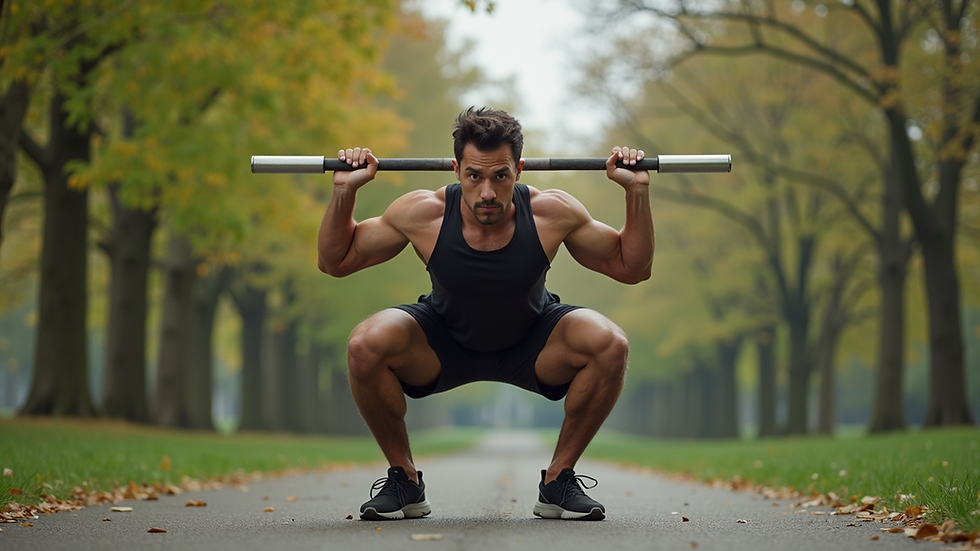Exploring the Efficacy of Bodyweight Squats Versus Jump Squats in Fat Loss Programs
- Dhivakar A
- Aug 11
- 3 min read
When it comes to fat loss, exercise selection plays a crucial role in achieving desired results. Among the myriad of exercises available, squats are a staple in many fitness routines. However, the debate between bodyweight squats and jump squats continues to spark interest among fitness enthusiasts. This blog post delves into the effectiveness of these two squat variations in the context of fat loss, helping you make an informed decision for your workout regimen.
Understanding Bodyweight Squats
Bodyweight squats are a fundamental exercise that targets the lower body, primarily the quadriceps, hamstrings, and glutes. This exercise is performed by lowering the body into a sitting position while keeping the feet flat on the ground.
The beauty of bodyweight squats lies in their accessibility; they require no equipment and can be performed anywhere. This makes them an excellent choice for individuals at any fitness level.
Moreover, bodyweight squats help improve flexibility, balance, and core strength, which are essential components of overall fitness.
However, while they are effective for building strength and endurance, the calorie burn associated with bodyweight squats may not be as high as some might expect, especially when compared to more dynamic movements.
The Mechanics of Jump Squats
Jump squats, on the other hand, add a plyometric element to the traditional squat. This explosive movement involves performing a squat and then jumping as high as possible before landing back into the squat position.
Jump squats engage the same muscle groups as bodyweight squats but with an added intensity that elevates the heart rate significantly.
This increase in intensity translates to a higher calorie burn during the exercise, making jump squats a powerful tool in fat loss programs.
Additionally, jump squats can enhance athletic performance by improving power and explosiveness, which can be beneficial for athletes and fitness enthusiasts alike.
Caloric Burn Comparison
When evaluating the effectiveness of bodyweight squats versus jump squats in fat loss, caloric burn is a critical factor.
Research indicates that jump squats can burn more calories in a shorter amount of time compared to bodyweight squats.
This is primarily due to the increased heart rate and energy expenditure required for the explosive movement.
For individuals looking to maximize their fat loss during workouts, incorporating jump squats may provide a more efficient approach.
However, it’s essential to consider individual fitness levels and preferences, as not everyone may be ready for the intensity of jump squats.
Muscle Engagement and Fat Loss
Both bodyweight squats and jump squats engage the lower body muscles effectively, but the way they do so differs.
Bodyweight squats focus on building strength and endurance in the muscles, while jump squats emphasize power and explosiveness.
This distinction is crucial for fat loss, as muscle engagement plays a significant role in overall metabolism.
The more muscle mass you have, the more calories your body burns at rest.
Incorporating both types of squats into a workout routine can provide a balanced approach, allowing for muscle building and increased caloric burn.
Injury Risk and Considerations
While both exercises are beneficial, it’s important to consider the risk of injury.
Bodyweight squats are generally safer for beginners, as they place less stress on the joints and require less coordination.
Jump squats, however, can lead to injuries if performed incorrectly or without proper warm-up.
Individuals with pre-existing knee or ankle issues should approach jump squats with caution and may benefit from focusing on bodyweight squats to build strength first.
Listening to your body and progressing at your own pace is essential for long-term success in any fitness program.
Incorporating Both Exercises into Your Routine
For optimal fat loss, a combination of bodyweight squats and jump squats can be highly effective.
Consider structuring your workouts to include both exercises, allowing for strength building and explosive movements.
For example, you might perform a set of bodyweight squats followed by a set of jump squats, alternating between the two.
This approach not only keeps your workouts varied and engaging but also maximizes caloric burn and muscle engagement.
Conclusion
In the battle of bodyweight squats versus jump squats for fat loss, both exercises have their unique advantages.
Bodyweight squats are excellent for building strength and endurance, while jump squats provide a higher caloric burn and enhance power.
Ultimately, the best choice depends on individual fitness levels, goals, and preferences.
Incorporating both exercises into your routine can lead to a well-rounded approach to fat loss, ensuring you reap the benefits of each.
As with any fitness program, consistency and proper form are key to achieving your goals.
By understanding the efficacy of bodyweight squats and jump squats, you can make informed decisions that align with your fat loss journey.






Comentarios